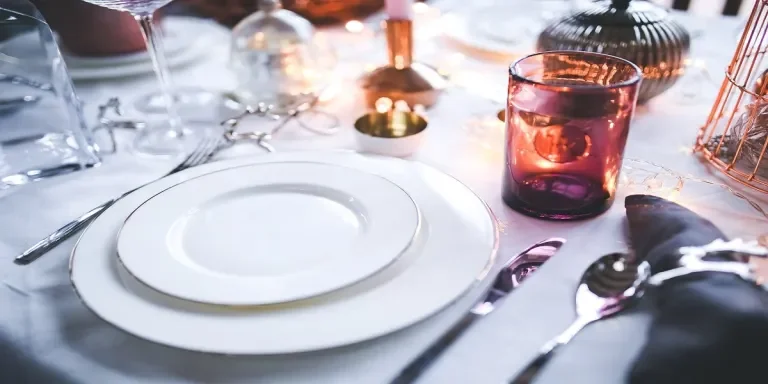Today’s tableware market has evolved extensively, displaying diversity across cultures, regions, and occasions. It includes a range of items from forks and spoons to serving utensils, glassware, and even dinnerware. This wide array of daily essentials has opened significant business opportunities for retailers catering to this segment.
Read on for a guide to choosing in-demand tableware based on consumer preferences, as well as an overview of the top five trends for tableware in 2024.
Table of Contents
1. Insights into the global tableware market
2. How to pick the right tableware to boost your sales
3. Top 5 tableware trends and forecasts for 2024
4. The next wave of dining style
Insights into the global tableware market
Multiple studies highlight the significant growth of the tableware and dinnerware market worldwide. The market was valued at around USD 45 billion and USD 47 billion respectively in 2020 and 2022 and the tableware market in particular is expected to grow to about USD 79 billion by 2030, at a healthy compound annual growth rate (CAGR) of 6.6% for the coming years. North America, especially the United States, continues to lead the market with its aggressive demands for tableware.
This stable growth forecast is fueled by several key factors. A notable increase in the number of households with increased spending power, alongside a growing consumer inclination towards premium cutlery products that not only meet functional needs but also enhance interior aesthetics is driving product demand.
The growth of the commercial sector, characterized by an increase in restaurants, cafes, and both independent and chain coffee shops, also significantly fuels the demand for tableware. This surge in dining and coffee culture emphasizes the need for varied and high-quality tableware, driving the hospitality industry to continually invest in and enhance its tableware products and services, which in turn consistently propels market development.
The lifestyle trend of living in rental homes, leading to frequent moves, is credited as another factor that encourages consumers to purchase new tableware for each new residence, further stimulating market growth.
How to pick the right tableware to boost your sales

In order for wholesalers to pick the right tableware to boost sales, it’s crucial to first identify the target customer segments, which essentially fall into two categories: general consumers and commercial users. It is vital to identify these targets since each of them comes with distinct requirements for tableware selection.
For instance, consumers are known for having unique preferences for tableware that best suits their individuality and reflects their personal style and taste, according to various industry experts and design magazines. Meanwhile, “casual comfort,” as opposed to a “formal” or “elegant” style of dinnerware, resonated with 79% of the participants in the latest Gift Book Consumer Survey, while the latter only gained 19% recognition.
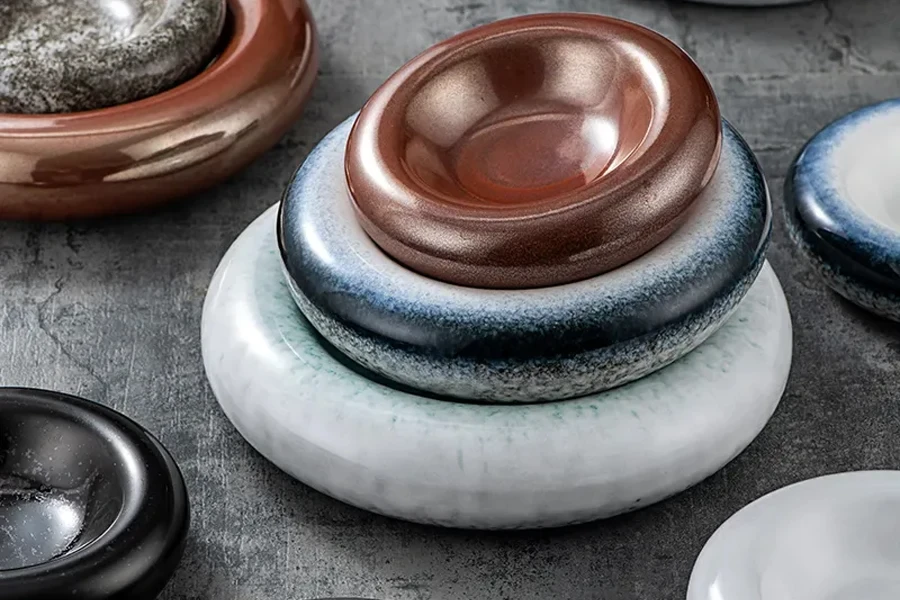
On the other hand, the constantly evolving global dining establishments continue to drive the need for stylish and modern tableware to further enhance the atmosphere and cater to their respective patrons effectively. In 2023 alone, statistics show that there are around 900 new restaurant openings every month in the United States. The expansion of this sector is, in fact, also highly driven by consumer preferences for convenience and quality foods and services, leading to the proliferation of contemporary and high-grade kitchen equipment.
Based on the above understanding of consumer preferences that are driving not only the general consumer tableware and dinnerware market but also the commercial sectors, a crucial tip for wholesalers is to address the needs of both segments by considering both the aesthetic appeal and the functional aspects of tableware.
It’s equally important for wholesalers to include a variety of tableware that can satisfy the requirements for both classic and modern tastes since consumers tend to showcase their personality through tableware selection.
Simultaneously, the growing number of new restaurateurs highlights a significant trend: the expansion of outdoor dining spaces, particularly in the wake of the recent years’ disruptions in the global health landscape. In fact, such outdoor dining expansion is highly supported by several local authorities, including in the cities of New York and Boston.
For wholesalers, this suggests the importance of selecting dinnerware that can transit between indoor and outdoor settings, a vital adaptability in helping restaurant owners maximize the use of their dinnerware across different spaces, meals, and dinner parties.
Top 5 tableware trends and forecasts for 2024
Bold patterns and graphic designs
As evident by various reports, in an era that valorizes self-expression and individuality—a trend amplified and popularized by social media—consumers are increasingly attracted to distinctive designs, particularly those featuring bold patterns and graphic designs, to effectively showcase their unique style and personality.
Tableware with bold pattern designs, displaying a visually compelling look (as seen below), is a clear testament to the evolving consumer preferences. Incorporating such vibrant, eye-catching designs not only rejuvenates the aesthetic appeal of dining tables but also responds to the growing demand for personalized table settings.
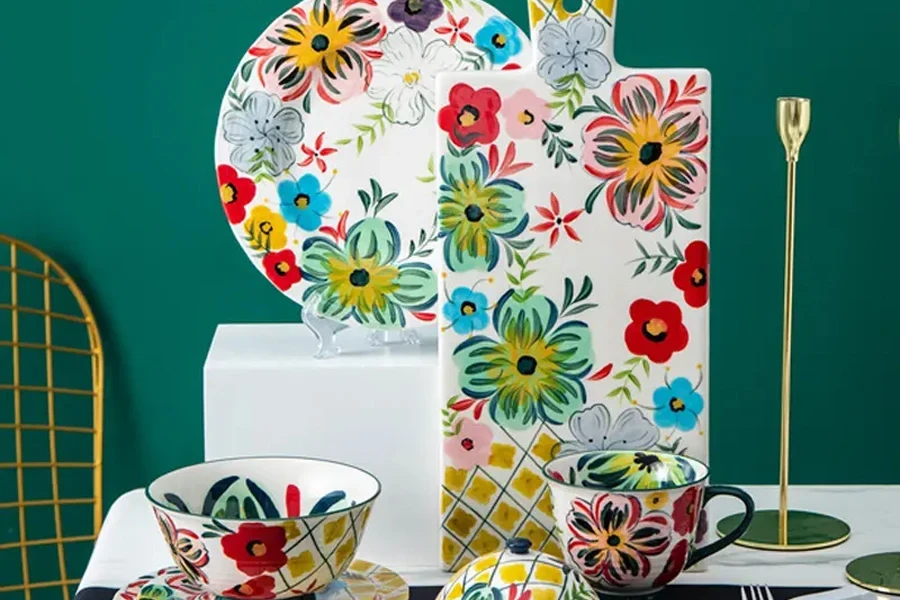
In the meantime, graphic designs, which are traditionally associated with media, advertising, or web design rather than tableware, are increasingly becoming integral to tableware design. With elevated aesthetic expectations from consumers, tableware incorporating graphic designs is now gaining popularity.
For wholesalers, this evolving trend represents a significant opportunity to display their innovative prowess and establish a distinctive brand identity, especially through unique graphic design concepts. This is particularly advantageous when wholesalers develop exclusive and instantly recognizable designs, such as tableware with a bold design featured in the picture below.

Emphasis on artistic and functional design
Artistry and functionality are no longer mutually exclusive in the world of tableware but can now seamlessly blend together. In the image below, we see an artistic, fan-shaped ceramic plate that features a distinctive reactive glaze color. Its stackable configuration facilitates effortless storage, while the plate’s robust thickness and sturdiness enhance its chip resistance.
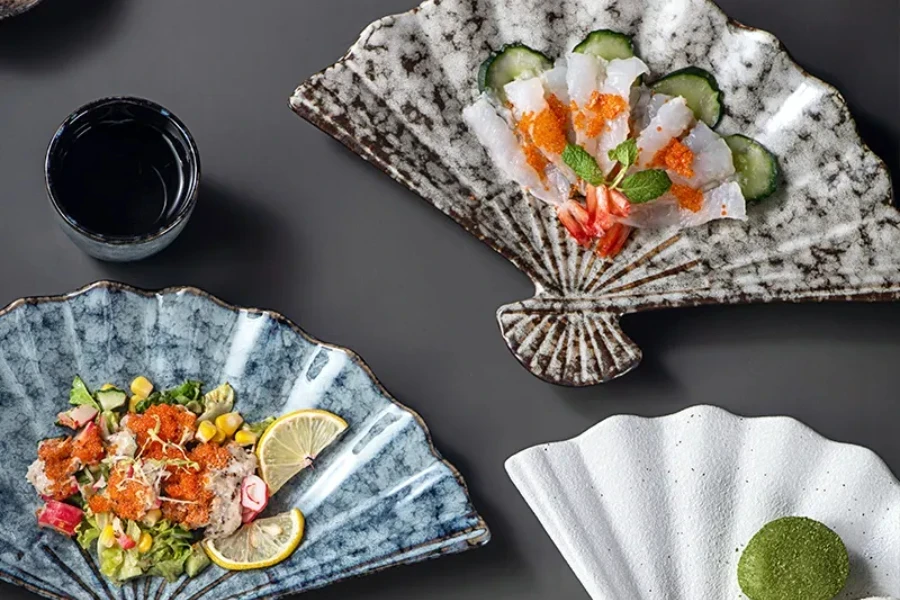
This balance between aesthetic appeal and practical use accentuates a vital trend in the tableware market, where artistic tableware melds with functional design to enhance the dining experience significantly.
Furthermore, It’s worth noting that tableware with artistic design does not necessarily imply complexity or vibrant color contrasts but can also present itself in simple, casually elegant, and inviting forms. Kiln-changing tableware, depicted in the image below, for example, provides both artistic expression and aesthetic value without resorting to intense coloration or detailed patterns. Enhancing this allure is its durable, heat-conserving, and adaptable ceramic quality, adding greater functional value to its aesthetic charm.
The focus on artistic designs also does not detract the tableware from the essential functionality, ensuring that while tableware acts as a visual feast, it adeptly fulfills the practical requisites of dining. This fusion of elegance and utility resonates with a broad spectrum of consumers, from design enthusiasts to daily users, manifesting a sophisticated artistic inclination within tableware with art design.
Revival and innovation of traditional motifs
Aside from bold patterns and artistic designs, the tableware industry is also witnessing a renaissance of traditional motifs, updated with modern twists to appeal to modern sensibilities.
As exhibited in the picture below, to resonate with today’s consumers, the rich heritage of tableware design is celebrated while infusing innovative designs. This showcases a sophisticated selection of classic tableware that beautifully embodies traditional motifs with creative modern design. The golden geometric shapes and patterns circling the plates offer a classic touch, while their sleek design injects a contemporary vibe.
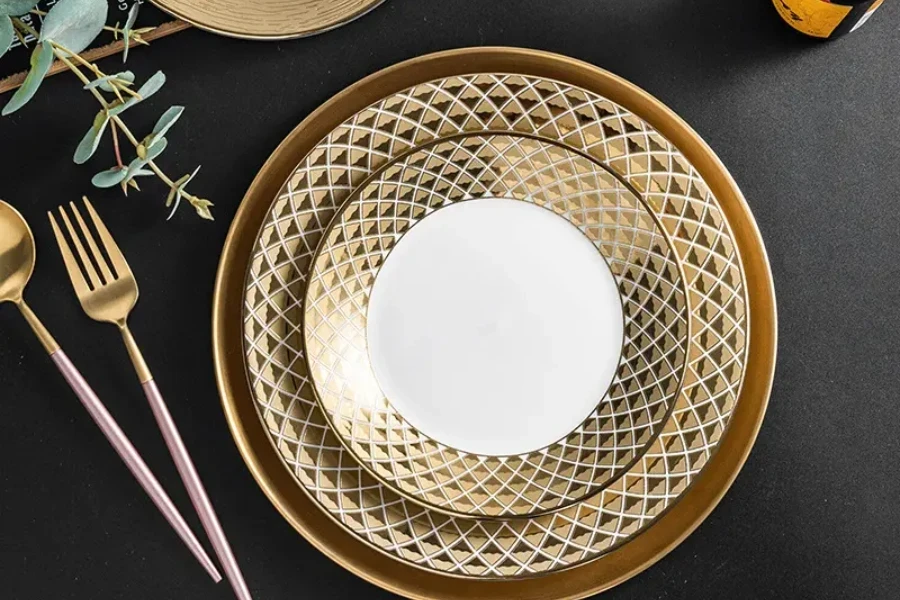
By reimagining classic designs, manufacturers are able to offer products that bridge the gap between the old and the new, providing consumers with both nostalgic and forward-looking products.
Overall, the revival and innovation of tableware with traditional motifs cater to the desire for tableware that is rooted in history yet suitable for contemporary living spaces. This is illustrated in the picture below, which features a tableware set that beautifully fuses traditional floral design with modern elegance.
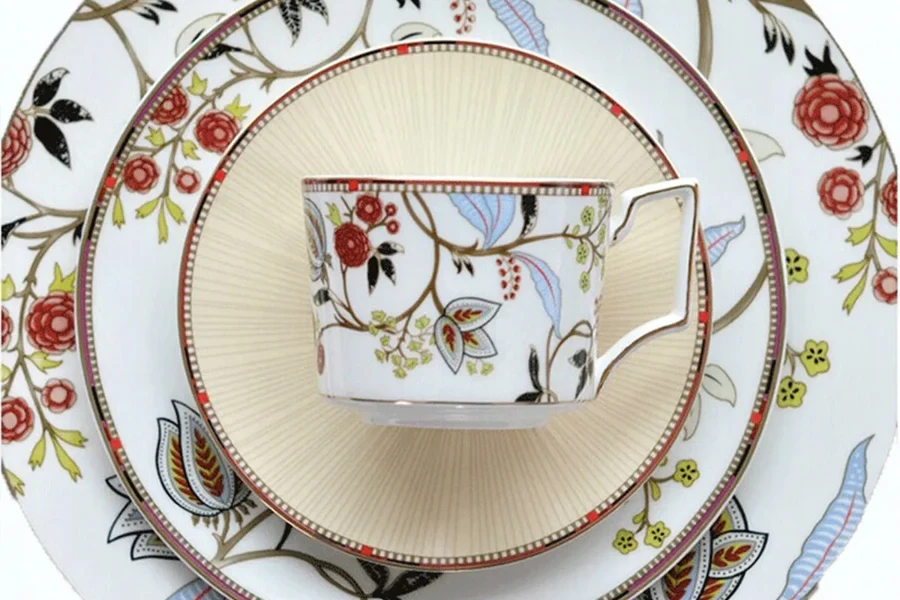
Incorporation of handcrafted and irregular shapes
On top of design differences and the rekindling of classic values, another trend that is highly recognized by various industry experts is the appreciation for handcrafted tableware. This handmade tableware, often with unique irregular shapes and an homage to vintage styles, is an apparent new favorite for the tableware designers. The customizable bowl made of natural materials, shown in the image below, exemplifies this trend. It offers the option for personalized engravings, thereby highlighting its eco-friendly materials and distinct texture.
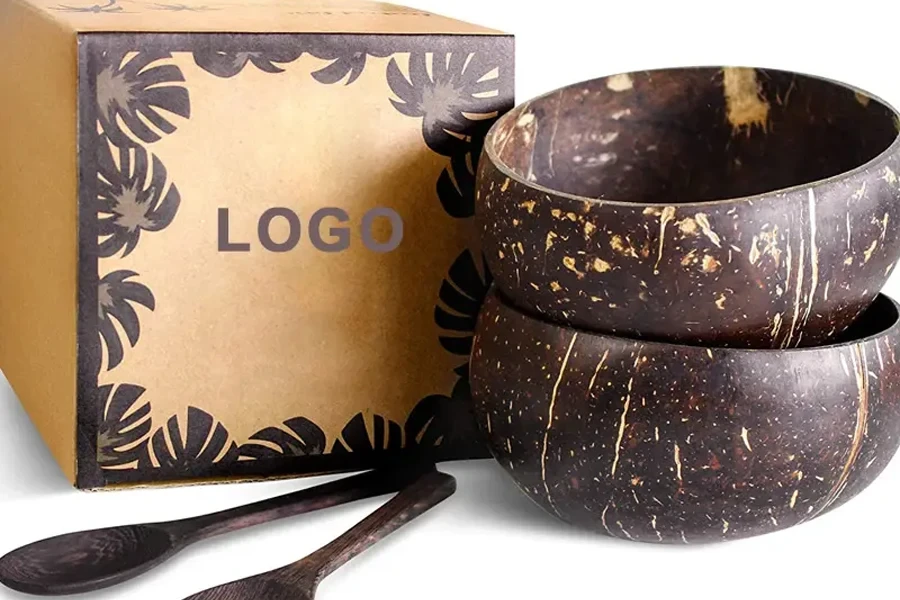
Meanwhile, tableware with irregular shapes also reflects a broader consumer interest in authenticity and the beauty of uniqueness and imperfection, since they often carry a sense of individuality and character, standing out from mass-produced items. This trend aligns with a growing consumer preference for items that tell a story, and concretize the skill and creativity of the artisan.
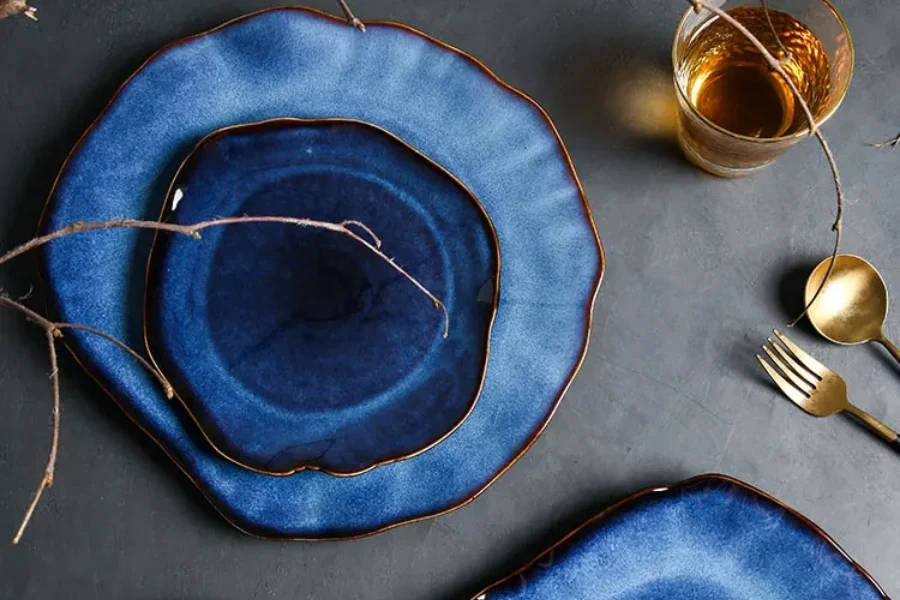
All in all, such a trend gives artisans and small-scale producers a voice and channel to express themselves while also enriching the dining rooms with specific items that are as unique as the individuals using them.
Expansion of color palettes
Lastly, a more colorful, bright color combination theme is another unmistakable trend in the tableware industry, as it accommodates an ever-widening array of personal tastes and seasonal trends.
This color expansion allows consumers to customize their table settings to align with their aesthetic preferences, creating dining experiences that are truly personalized. Colorful tableware, especially tableware with bright variants, caters to different occasions, moods, and interior designs, enabling consumers to curate their tableware collections in a way that expresses freedom and creativity.
This trend not only enhances the visual appeal of tableware but also empowers consumers to express their unique identity through their choice of dining essentials, offering the flexibility to mix and match pieces for a table setting that reflects individual styles.
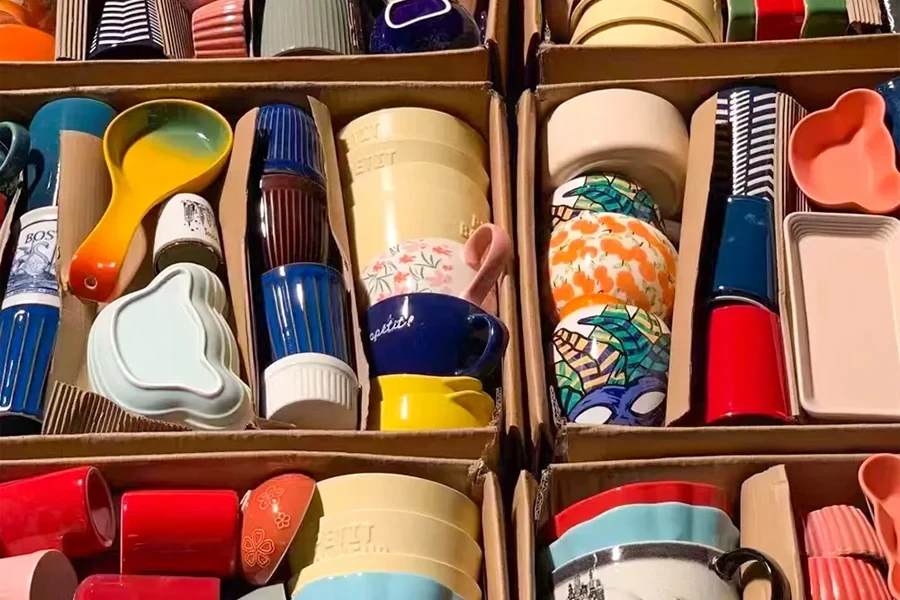
The next wave of dining style
As the year unfolds, several trends are poised to shape the tableware and dinnerware segment. These include the emergence of vibrant graphics and patterns, a harmonious blend of artistic flair and practical design, and the revival of classic motifs alongside the introduction of asymmetrical and handmade shapes. Additionally, the expanding palette of color schemes reflects a growing desire for personalization and uniqueness in table settings. Retailers can follow these trends closely when stocking up for the year ahead as they can ensure that one’s inventory is closely matched to consumer demand.
Finally, remember to visit Alibaba Reads to stay up-to-date with the transformative trends shaping the future of tableware and other key consumer segments in 2024.
